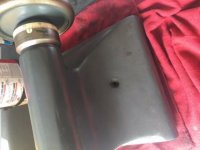sam_stlouis
Cast Iron
- Joined
- Aug 1, 2010
- Location
- missouri, USA
Doing maintence on my hlvh I've had it a little while but am just now getting it going. Moving the tailstock today and a white strip starts coming out from under it. So I took it off to look under it. It had several white strips of material. Half are missing. And what looks like someone took a engraver and randomly etched the base, it is smooth no raised surfaces. I'm thinking the engraving was to give the strips something to cling to. I know the base had a nylon type material originally. Are these white strips the original material, and if so where can I buy some. I can't find any pictures of the bottom side of an hlvh tailstock, is this how they normally look, or did someone try to do some kind of repair. Thanks for any help
I guess I will have to upload pic when I get home does not want to seem to upload on my phone
I guess I will have to upload pic when I get home does not want to seem to upload on my phone




